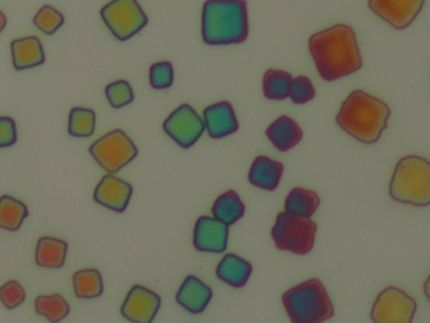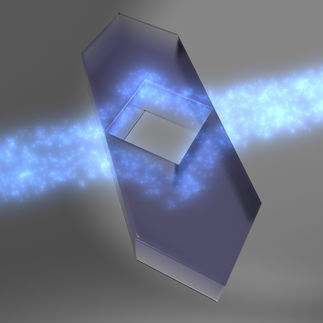Nano bulb lights novel path
Rice University engineers create tunable, nanoscale, incandescent light source
What may be viewed as the world's smallest incandescent lightbulb is shining in a Rice University engineering laboratory with the promise of advances in sensing, photonics and perhaps computing platforms beyond the limitations of silicon.

Nanoscale thermal emitters created at Rice University combine several known phenomena into a unique system that turns heat into light. The system is highly configurable to deliver light with specific properties and at the desired wavelength.
Illustration by Chloe Doiron/Rice University
Gururaj Naik of Rice's Brown School of Engineering and graduate student Chloe Doiron have assembled unconventional "selective thermal emitters" -- collections of near-nanoscale materials that absorb heat and emit light.
Their research, reported in Advanced Materials, one-ups a recent technique developed by the lab that uses carbon nanotubes to channel heat from mid-infrared radiation to improve the efficiency of solar energy systems.
The new strategy combines several known phenomena into a unique configuration that also turns heat into light -- but in this case, the system is highly configurable.
Basically, Naik said, the researchers made an incandescent light source by breaking down a one-element system -- the glowing filament in a bulb -- into two or more subunits. Mixing and matching the subunits could give the system a variety of capabilities.
"The previous paper was all about making solar cells more efficient," said Naik, an assistant professor of electrical and computer engineering. "This time, the breakthrough is more in the science than the application. Basically, our goal was to build a nanoscale thermal light source with specific properties, like emitting at a certain wavelength, or emitting extremely bright or new thermal light states.
"Previously, people thought of a light source as just one element and tried to get the best out of it," he said. "But we break the source into many tiny elements. We put sub-elements together in such a fashion that they interact with each other. One element may give brightness; the next element could be tuned to provide wavelength specificity. We share the burden among many small parts.
"The idea is to rely upon collective behavior, not just a single element," Naik said. "Breaking the filament into many pieces gives us more degrees of freedom to design the functionality."
The system relies on non-Hermitian physics, a quantum mechanical way to describe "open" systems that dissipate energy -- in this case, heat -- rather than retain it. In their experiments, Naik and Doiron combined two kinds of near-nanoscale passive oscillators that are electromagnetically coupled when heated to about 700 degrees Celsius. When the metallic oscillator emitted thermal light, it triggered the coupled silicon disk to store the light and release in the desired manner, Naik said.
The light-emitting resonator's output, Doiron said, can be controlled by damping the lossy resonator or by controlling the level of coupling through a third element between the resonators. "Brightness and the selectivity trade off," she said. "Semiconductors give you a high selectivity but low brightness, while metals give you very bright emission but low selectivity. Just by coupling these elements, we can get the best of both worlds."
"The potential scientific impact is that we can do this not just with two elements, but many more," Naik said. "The physics would not change."
He noted that though commercial incandescent bulbs have given way to LEDs for their energy efficiency, incandescent lamps are still the only practical means to produce infrared light. "Infrared detection and sensing both rely on these sources," Naik said. "What we've created is a new way to build light sources that are bright, directional and emit light in specific states and wavelengths, including infrared."
The opportunities for sensing lie at the system's "exceptional point," he said.
"There's an optical phase transition because of how we've coupled these two resonators," Naik said. "Where this happens is called the exceptional point, because it's exceptionally sensitive to any perturbation around it. That makes these devices suitable for sensors. There are sensors with microscale optics, but nothing has been shown in devices that employ nanophotonics."
The opportunities may also be great for next-level classical computing. "The International Roadmap for Semiconductor Technology (ITRS) understands that semiconductor technology is reaching saturation and they're thinking about what next-generation switches will replace silicon transistors," Naik said. "ITRS has predicted that will be an optical switch, and that it will use the concept of parity-time symmetry, as we do here, because the switch has to be unidirectional. It sends light in the direction we want, and none comes back, like a diode for light instead of electricity."






























































